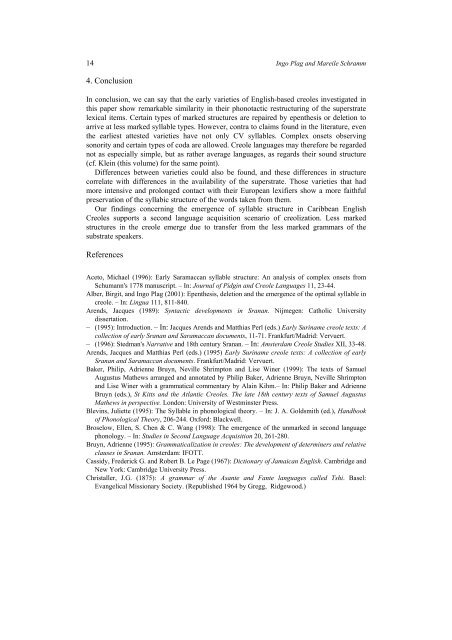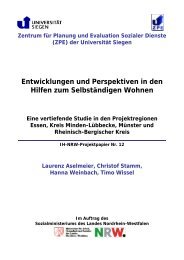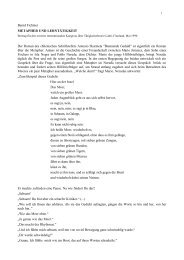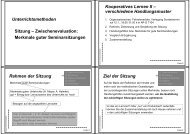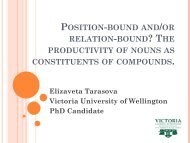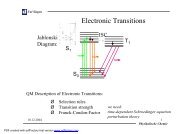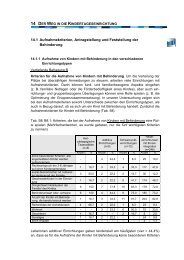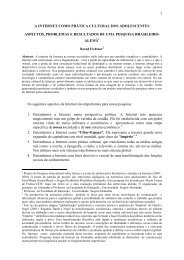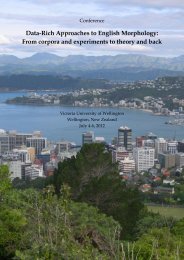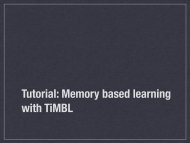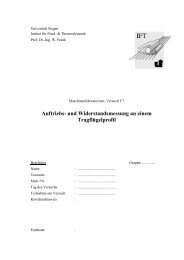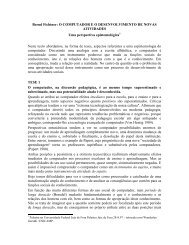Early creole syllable structure: evidence from early varieties
Early creole syllable structure: evidence from early varieties
Early creole syllable structure: evidence from early varieties
Create successful ePaper yourself
Turn your PDF publications into a flip-book with our unique Google optimized e-Paper software.
14 Ingo Plag and Mareile Schramm4. ConclusionIn conclusion, we can say that the <strong>early</strong> <strong>varieties</strong> of English-based <strong>creole</strong>s investigated inthis paper show remarkable similarity in their phonotactic restructuring of the superstratelexical items. Certain types of marked <strong>structure</strong>s are repaired by epenthesis or deletion toarrive at less marked <strong>syllable</strong> types. However, contra to claims found in the literature, eventhe earliest attested <strong>varieties</strong> have not only CV <strong>syllable</strong>s. Complex onsets observingsonority and certain types of coda are allowed. Creole languages may therefore be regardednot as especially simple, but as rather average languages, as regards their sound <strong>structure</strong>(cf. Klein (this volume) for the same point).Differences between <strong>varieties</strong> could also be found, and these differences in <strong>structure</strong>correlate with differences in the availability of the superstrate. Those <strong>varieties</strong> that hadmore intensive and prolonged contact with their European lexifiers show a more faithfulpreservation of the syllabic <strong>structure</strong> of the words taken <strong>from</strong> them.Our findings concerning the emergence of <strong>syllable</strong> <strong>structure</strong> in Caribbean EnglishCreoles supports a second language acquisition scenario of creolization. Less marked<strong>structure</strong>s in the <strong>creole</strong> emerge due to transfer <strong>from</strong> the less marked grammars of thesubstrate speakers.ReferencesAceto, Michael (1996): <strong>Early</strong> Saramaccan <strong>syllable</strong> <strong>structure</strong>: An analysis of complex onsets <strong>from</strong>Schumann's 1778 manuscript. – In: Journal of Pidgin and Creole Languages 11, 23-44.Alber, Birgit, and Ingo Plag (2001): Epenthesis, deletion and the emergence of the optimal <strong>syllable</strong> in<strong>creole</strong>. – In: Lingua 111, 811-840.Arends, Jacques (1989): Syntactic developments in Sranan. Nijmegen: Catholic Universitydissertation.– (1995): Introduction. – In: Jacques Arends and Matthias Perl (eds.) <strong>Early</strong> Suriname <strong>creole</strong> texts: Acollection of <strong>early</strong> Sranan and Saramaccan documents, 11-71. Frankfurt/Madrid: Vervuert.– (1996): Stedman's Narrative and 18th century Sranan. – In: Amsterdam Creole Studies XII, 33-48.Arends, Jacques and Matthias Perl (eds.) (1995) <strong>Early</strong> Suriname <strong>creole</strong> texts: A collection of <strong>early</strong>Sranan and Saramaccan documents. Frankfurt/Madrid: Vervuert.Baker, Philip, Adrienne Bruyn, Neville Shrimpton and Lise Winer (1999): The texts of SamuelAugustus Mathews arranged and annotated by Philip Baker, Adrienne Bruyn, Neville Shrimptonand Lise Winer with a grammatical commentary by Alain Kihm.– In: Philip Baker and AdrienneBruyn (eds.), St Kitts and the Atlantic Creoles. The late 18th century texts of Samuel AugustusMathews in perspective. London: University of Westminster Press.Blevins, Juliette (1995): The Syllable in phonological theory. – In: J. A. Goldsmith (ed.), Handbookof Phonological Theory, 206-244. Oxford: Blackwell.Broselow, Ellen, S. Chen & C. Wang (1998): The emergence of the unmarked in second languagephonology. – In: Studies in Second Language Acquisition 20, 261-280.Bruyn, Adrienne (1995): Grammaticalization in <strong>creole</strong>s: The development of determiners and relativeclauses in Sranan. Amsterdam: IFOTT.Cassidy, Frederick G. and Robert B. Le Page (1967): Dictionary of Jamaican English. Cambridge andNew York: Cambridge University Press.Christaller, J.G. (1875): A grammar of the Asante and Fante languages called Tshi. Basel:Evangelical Missionary Society. (Republished 1964 by Gregg, Ridgewood.)


